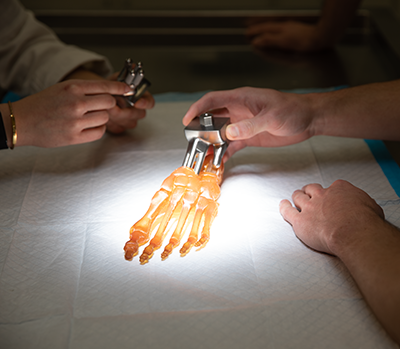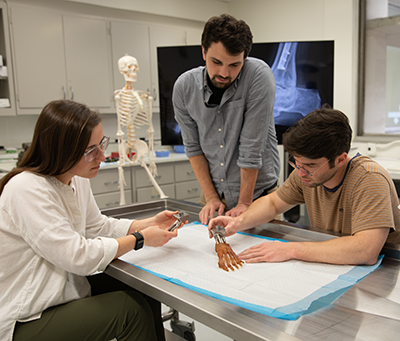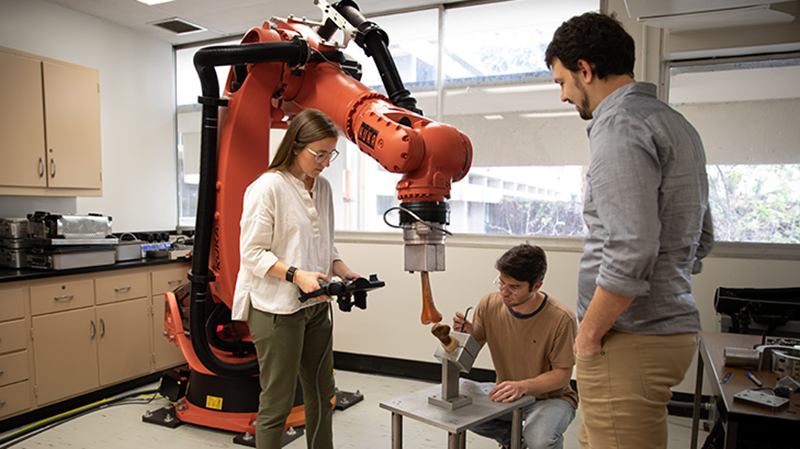Award-winning UCLA engineer Tyler Clites aims to improve human mobility
From the outside, the UCLA Outpatient Rehabilitation Services looks like most other physical therapy and rehabilitation centers, complete with a check-in desk and a waiting room filled with patients. But just one floor above is a set of laboratories at the forefront of innovative technologies, where engineers and surgeons work together to develop bionic systems designed to improve quality of life for patients.
One such lab is the UCLA Anatomical Engineering Group led by principal investigator Tyler Clites, an assistant professor of mechanical and aerospace engineering at the UCLA Samueli School of Engineering. Clites’ research focuses on improving human mobility through rehabilitation, which aims to restore function lost to disease or injury, and augmentation, which involves improving function beyond baseline human performance.
“Solving these types of problems is a highly interdisciplinary effort, and requires a team with diverse training and experience,” said Clites, who also holds joint appointments in bioengineering and the Department of Orthopaedic Surgery at the David Geffen School of Medicine.
Bionic implants for the foot and knee to prevent amputations and ACL injuries
Each year, thousands of patients have to make the difficult decision to amputate a foot due to severe pain and dysfunction caused by infections or diseases such as diabetes. The conventional approach to preserving the appendage is ankle-hindfoot fusion surgery, which essentially creates one solid bone in that region of the foot. Unfortunately, the procedure fails about 30% of the time, Clites said, in which case the foot is likely to be amputated. Even with successful surgery, patients may suffer from drastically reduced range of motion that causes some to opt for amputation.
“We use surgery to engineer the body in parallel with the machine, opening the door to bionic systems that integrate more fully with the human,” said Tyler Clites.
Clites’ lab is developing an implanted ankle-hindfoot prosthesis that has the potential to alleviate pain and restore function to these patients, without requiring amputation.
“Typically, when developing bionic systems, engineers focus their design efforts on the machine but leave the body unaltered,” said Clites, who recently received a National Institutes of Health (NIH) Director’s New Innovator Award. “Instead, we use surgery to engineer the body in parallel with the machine, opening the door to bionic systems that integrate more fully with the human.”
Led by third-year mechanical and aerospace engineering doctoral student Brandon Peterson, the project is a multidisciplinary collaboration involving Clites’ lab, Dr. Nelson SooHoo in the Department of Orthopaedic Surgery at UCLA and Jonathan Hopkins — an associate professor in UCLA Samueli’s Department of Mechanical and Aerospace Engineering.
“Our innovative implant design necessitates collaboration between engineers and surgeons, which makes for a unique Ph.D. experience,” Peterson said. “One day I’m helping dissect a cadaver to learn about the surrounding bones and tissue, and the next day I’m using that information to iterate on the mechanical design of the implant.”
Ophelie Herve, another third-year mechanical and aerospace engineering Ph.D. student in Clites’ lab, leads a project exploring the use of an implant to prevent one of the most common knee injuries among athletes — an anterior cruciate ligament (ACL) sprain or tear.
ACL injuries have become an epidemic, especially among young athletes and women. According to the National Center for Biotechnology Information, female athletes are two to eight times more likely to tear their ACL compared to their male counterparts. While the root cause of the disparity is not yet fully understood, Clites said it is due in part to anatomical differences and the systemic inadequacies of training regimens developed primarily for male bodies.

Despite extensive reconstructive efforts, ACL injuries tend to carry serious long-term consequences, including a dramatically increased risk for early-onset osteoarthritis. Herve is working with UCLA physicians David McAllister and Thomas Kremen in the Department of Orthopaedic Surgery on designing a small implant that can be put in place to eliminate the risk of an ACL injury.
However, Clites said the project also poses an important question: If the risk and cost of injury were high enough, would a healthy person choose to undergo a surgical procedure to reduce that risk?
A former soccer player herself, Herve has witnessed firsthand the impact of ACL injuries on her teammates.
“Although the end goal of this research is ambitious, I draw on the stories of the women and men I know whose lives were changed because of their injury,” Herve said. “I see an opportunity here to restore mobility and protect a vulnerable ligament in hopes of enabling more people to remain active and engaged in a sport or activity that makes them happy, and thus their life more whole.”
An integration of engineering and medicine
The Anatomical Engineering Group’s facilities in the UCLA Outpatient Rehabilitation Services are as multidisciplinary as the team that calls them home.
The first room of the laboratory is a fully functional operating room. Complete with surgical lighting, an operating table, sterilized surgical instruments and anatomical posters on the clean white walls, the surgical innovation suite is the place where Clites and his team test the surgical methods necessary to implant their devices. They also study cadaverous specimens from all genders, ages and races to ensure their technologies can help a diverse population.
A few doors down is the team’s biomechanical experimentation room. While fairly spacious, the room is preoccupied by a massive, orange robotic arm that just barely clears the ceiling. The KUKA robot can be programmed to simulate human motion on cadaveric or model human joints.
Herve and Peterson developed a computational system that takes human movement data obtained from biplanar fluoroscopy — which essentially functions like a video X-ray machine — and converts it into commands that KUKA can understand. Using this system, the robot can reproduce any motion in three-dimensional space.
“We could have you walk on a treadmill, record how your knee is moving and then replay that exact motion on a cadaveric or model knee,” Clites said.
With his research at the nexus of engineering and orthopedic surgery, Clites credits UCLA’s strengths in engineering and medicine for his research capabilities.
“UCLA is built to foster the clinical collaborations that are fundamental to my research,” Clites said. “This goes beyond sheer proximity between the engineering and medical campuses. Research is deeply rooted in the culture of the Department of Orthopaedic Surgery, which has made it a pleasure to find and maintain close collaborative relationships.”
A journey: the past, present and future
Clites has been exploring bionics since he was an undergraduate at Harvard University. He was first brought into the field by David Sengeh, then a graduate student at the Massachusetts Institute of Technology working on improving prosthetic sockets and now the chief science minister for the country of Sierra Leone.

Through a joint program between Harvard Medical School and MIT, Clites continued his studies under the direction of MIT’s mechanical and aerospace engineering professor Hugh Herr, who specialized in bionics.
“Hugh taught me to innovate, and gave me a powerful framework for thinking about bionic systems and disability,” Clites said.
In addition to conducting research on bionic systems, Clites also teaches graduate and undergraduate mechanical and aerospace engineering courses at UCLA. He often finds ways to incorporate real-life challenges into his teaching.
For an undergraduate mechanical engineering class on differential equations, Clites builds many homework problems designed to address common issues in wearable robotics. In his graduate-level course on bionic systems, Clites introduces his students to the same tools and concepts used in his lab designed to address limitations in human mobility.
Clites also teaches a senior design capstone project for mechanical engineering students in which he guides student teams in developing medical devices that address real clinical problems.
Beyond his recent NIH award, Clites was named to the 2018 Forbes 30 Under 30 List, and was honored as one of the Boston Globe’s 2018 STAT Wunderkinds. His research has also been featured by TED, The New York Times and CNN among others.
Harnessing the ingenuity that earned those plaudits, Clites has his sights firmly fixed on the future, and how his team can improve human health and well-being.
“We will continue to do research aimed at solving long-standing problems in rehabilitation and augmentation technology,” he said. “As we expand to new problems, the lab will grow to meet the needs of the projects.”
Natalie Weber contributed to this story.

